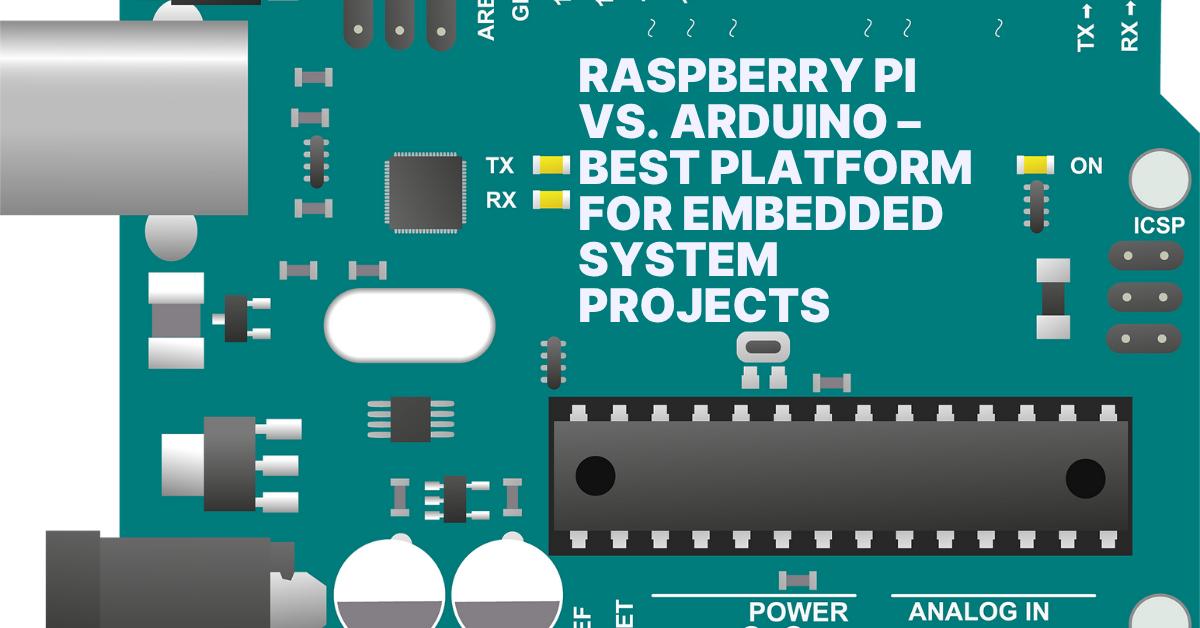Raspberry Pi vs. Arduino – Best Platform for Embedded System Projects
Embedded system projects range from simple sensor controllers to complex autonomous devices. Choosing between Raspberry Pi and Arduino depends on processing needs, real-time requirements, power consumption, connectivity, and ease of development. This report examines both platforms across these dimensions to help you select the right tool.

- Platform Overview
Arduino
Arduino boards are microcontroller-based platforms designed for direct hardware control without an operating system. They use simple firmware written in C/C++ and start executing code immediately on power-up, making them ideal for deterministic, low-latency tasks .
Raspberry Pi
Raspberry Pi is a single-board computer running a Linux-based OS (e.g., Raspberry Pi OS). It offers powerful CPU, GPU, multimedia capabilities, and high-level programming via Python, C++, or other languages. It requires proper shutdown but supports complex applications like computer vision and web servers .
- Processing Power and Memory
| Feature | Arduino Uno Rev3 | Raspberry Pi 4 Model B |
| CPU | 16 MHz AVR ATmega328P | Quad-core Cortex-A72 @1.8 GHz |
| RAM | 2 KB SRAM | 1 GB–8 GB LPDDR4 |
| Flash/Storage | 32 KB Flash | MicroSD card (OS and storage) |
| Operating System | None | Linux-based OS |
Arduino’s limited clock speed and memory suit simple I/O tasks . Raspberry Pi’s multicore architecture and gigabytes of RAM enable resource-intensive applications .
- Real-Time Capability
- Arduino executes code in bare-metal fashion, providing predictable timing and deterministic response, essential for motor control, sensor sampling, and closed-loop systems .
- Raspberry Pi, running Linux, can have unpredictable scheduling delays. Real-time extensions (e.g., PREEMPT_RT kernel) or dedicated libraries (pigpio, WiringPi) improve timing but cannot match Arduino’s native determinism.
- Power Consumption and Cost
- Arduino Uno Rev3 draws ~50 mA (0.25 W) at 5 V; costs around $20 .
- Raspberry Pi 4 Model B consumes 600 mA–1 A (3–5 W) depending on workload; costs $35–$75 depending on RAM.
For battery-powered or cost-sensitive applications, Arduino’s lower power draw and price are advantageous.
- I/O and Connectivity
Arduino I/O
- Digital I/O: 14 pins (6 PWM)
- Analog inputs: 6 channels
- Communication: UART, I²C, SPI
- Expandability: Shields for Ethernet, Wi-Fi, motor drivers
Raspberry Pi I/O
- GPIO: 40-pin header (digital only)
- No native analog inputs (requires external ADC)
- Communication: UART, I²C, SPI, CSI (camera), DSI (display)
- Connectivity: Gigabit Ethernet, dual-band Wi-Fi, Bluetooth 5.0, USB 3.0
Arduino provides built-in analog channels; Raspberry Pi needs add-ons. Pi excels in networking and multimedia interfaces.
- Development Ecosystem
- Arduino IDE offers straightforward code uploading, serial monitoring, and extensive libraries for sensors and actuators .
- Raspberry Pi supports SSH, remote desktop, and full IDEs (Thonny, VS Code). Complex software stacks (databases, web servers, AI frameworks) are easily deployed.
Arduino’s simplicity suits beginners. Raspberry Pi’s Linux environment enables professional development workflows.
- Use-Case Scenarios
Choose Arduino When:
- Hard real-time control of motors, actuators, or time-critical sensors is required.
- Minimal power consumption and cost are priorities.
- Projects demand built-in analog I/O without external modules.
Choose Raspberry Pi When:
- High computational power is needed for image processing, machine learning, or multimedia.
- Networking (web servers, IoT gateways) and USB peripherals are essential.
- Development benefits from a full OS, scripting languages, and complex software stacks.
- Hybrid Architectures
Many projects combine both platforms: Arduino handles deterministic I/O and low-level control, while Raspberry Pi manages high-level processing, networking, and data analytics. Communication between them uses serial, I²C, or network protocols, leveraging each platform’s strengths.
Conclusion
Arduino and Raspberry Pi each excel in specific embedded domains. Arduino’s real-time determinism, low power, and analog support make it ideal for microcontroller applications. Raspberry Pi’s processing power, connectivity, and OS ecosystem suit complex, networked, or multimedia-rich projects. Choose based on real-time requirements, computational demands, and ecosystem needs—or combine both in hybrid designs for comprehensive solutions.
